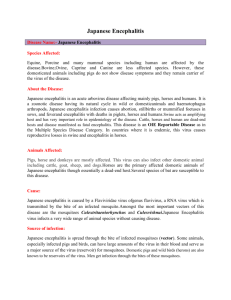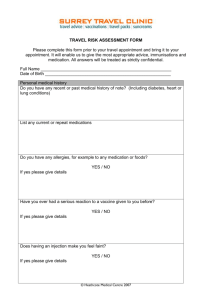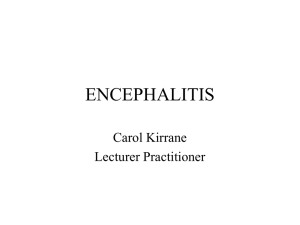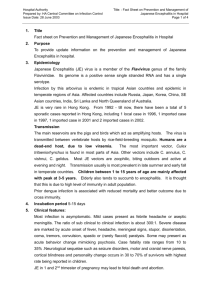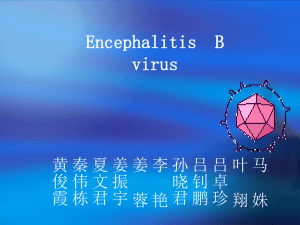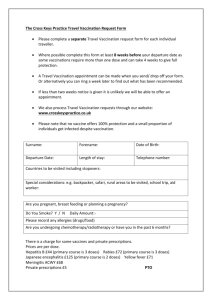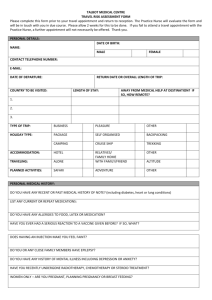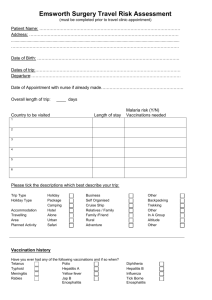Epidemiology - Infectiologie
advertisement
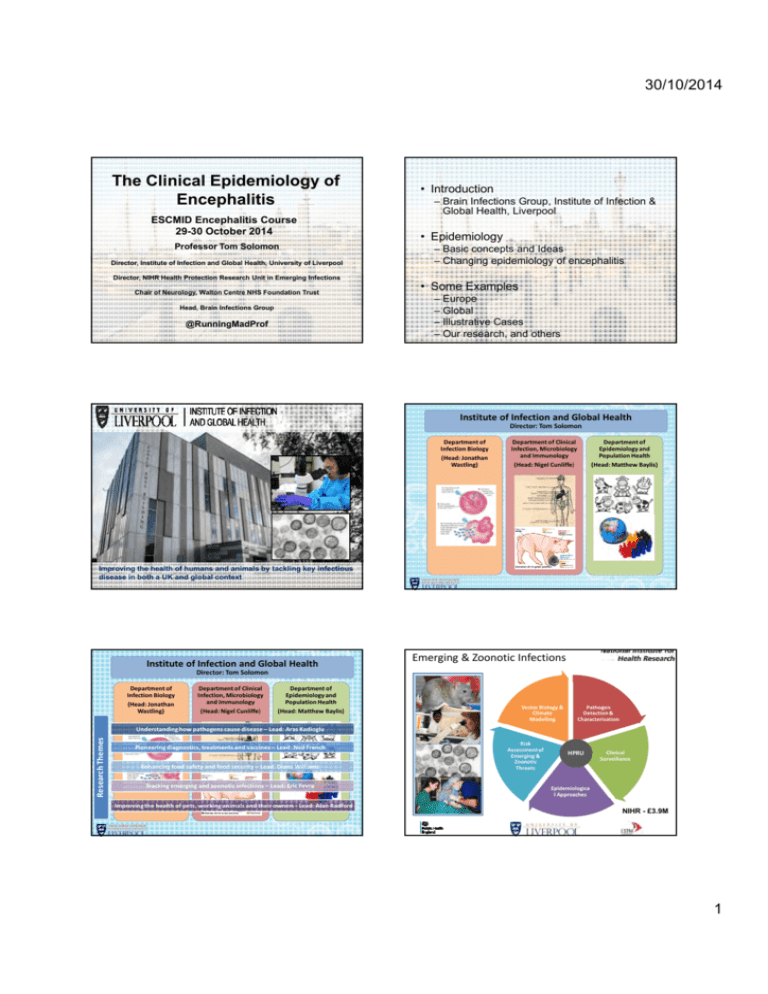
30/10/2014 The Clinical Epidemiology of Encephalitis ESCMID Encephalitis Course 29-30 October 2014 Professor Tom Solomon Director, Institute of Infection and Global Health, University of Liverpool • Introduction – Brain Infections Group, Institute of Infection & Global Health, Liverpool • Epidemiology – Basic concepts and Ideas – Changing epidemiology of encephalitis Director, NIHR Health Protection Research Unit in Emerging Infections Chair of Neurology, Walton Centre NHS Foundation Trust Head, Brain Infections Group @RunningMadProf • Some Examples – Europe – Global – Illustrative Cases – Our research, and others Institute of Infection and Global Health Director: Tom Solomon Department of Infection Biology (Head: Jonathan Wastling) Department of Clinical Infection, Microbiology and Immunology (Head: Nigel Cunliffe) Department of Epidemiology and Population Health (Head: Matthew Baylis) Improving the health of humans and animals by tackling key infectious disease in both a UK and global context Institute of Infection and Global Health Health Protection Research Unit in Emerging & Zoonotic Infections Director: Tom Solomon Department of Infection Biology (Head: Jonathan Wastling) Department of Clinical Infection, Microbiology and Immunology (Head: Nigel Cunliffe) Department of Epidemiology and Population Health (Head: Matthew Baylis) Vector Biology & Climate Modelling Pathogen Detection & Characterisation Research Themes Understanding how pathogens cause disease – Lead: Aras Kadioglu Pioneering diagnostics, treatments and vaccines – Lead: Neil French Enhancing food safety and food security – Lead: Diana Williams Tracking emerging and zoonotic infections – Lead: Eric Fevre Improving the health of pets, working animals and their owners - Lead: Alan Radford Risk Assessment of Emerging & Zoonotic Threats HPRU Clinical Surveillance Epidemiologica l Approaches NIHR - £3.9M 1 30/10/2014 HPRU EBOLA WORK Liverpool Brain Infections Group Neurological Science Neuroscience Division of Child Health Tropical Medicine NIHR Biomedical Research Centre in Microbial Diseases Infectious Diseases Vector Biology Division of Medical Microbiology School of Tropical Medicine Paediatrics Wellcome Trust Tropical Medicine Zoonotic Diseases Virology School of Biological Science Veterinary Medicine School of Biomedical Science c/o Julian Hiscox £9.4 M (US$ 15.2M) in Research Income National Centre for Zoonotic Diseases Brain Infections Group Research Disciplines Translation Research Pathogenesis • • • • Experimental Medicine Applied / Programmatics Clinical Research Public Health Molecular Virology Inflammation Histopathology Disease models • • • • • Clinical Epidemiology Diagnostics Pathophysiology Case management Treatment trials • • • • With WHO Disease burden Education Vaccine implementation Research Areas HIV Brain Disease Enterovirus 71, Rabies Jap Enceph, Dengue, West Nile Dual CNS Infections Herpes encephalitis Liverpool Brain Infections Group International Collaborations • University of Oxford-Wellcome Trust Clinical Research Unit, Centre for Tropical Diseases, Ho Chi Minh City (since 1994) • Armed Forces Research Institute of Medical Sciences (AFRIMS), Bangkok, Thailand (since 1994) • Institute of Health and Community Medicine, Universiti Malaysia Sarawak, Malaysia (Since 1997) • University of Texas Medical Branch, Galveston, Texas (since 2001) • Queen Elizabeth Hospital, Blantyre, Malawi (since 2003) • National Institute for Mental Health and Neurological Science (NIMHANS), Bangalore, India (since 2004) • Centres for Disease Control Atlanta, and Colorado, Texas (since 2007) • Kanti Children’s Hospital, Kathmandu, Nepal (since 2009) • Indian Institute for Science, Bangalore (2009) • John Hopkins Baltimore, USA (2009) • Washington University St Louis, USA (2009) • Lerner Research Institute, Cleveland, Ohio (2010) 2 30/10/2014 Epidemiology? Epidemiology • “the science that studies the patterns, causes, and effects of health and disease conditions in defined populations. • It is the cornerstone of public health, and informs policy decisions and evidencebased practice by identifying risk factors for disease and targets for preventive healthcare.” Clinical epidemiology • The application of the science of epidemiology in a clinical setting. Emphasis is on a medically defined population, as opposed to statistically formulated disease trends derived from examination of larger population categories. Life as a virus Epidemiology • Who gets disease? • How? Why? When? Where? • Any impact of Disease control? – Vaccination? Other? • Clinical epidemiology • In addition: – how do they present, clinical features? – Diagnostics important, treatment? @RunningMadProf Facebook.com/IGHLiverpool 3 30/10/2014 Reproduction Virus replication (sex) 10 genes 24,000 genes www.accessexcellence.org @RunningMadProf Facebook.com/IGHLiverpool @RunningMadProf Happy layer of cells Viruses Hiders Unhappy dengue virus infected of cells Facebook.com/IGHLiverpool @RunningMadProf and Jumpers Facebook.com/IGHLiverpool Herpes simplex virus Brain Infections: • How does pathogen get into the body? • How does it get into the Central Nervous System? 4 30/10/2014 Respiratory Jumping Viruses Routes of spread? • • • • • • • Respiratory Gastrointestinal Mucosal Insect-borne Injections Congenital (mother to child) Sexually transmitted @RunningMadProf Facebook.com/IGHLiverpool eofdreams.com Mucosal Gastrointestinal www.motherandbaby.com.au/ funstuffcafe.com Sexually Transmitted Insect-borne www.news.liv.ac.uk 5 30/10/2014 Tropical Viral Infections • Six questions to get a handle • What is the Natural host? • Where? – Animals (zoonoses) – Humans – Unknown • What is the habitat? – Urban – Rural • Pathogen – Bacteria, virus, parasite, causing disease – On Globe • What disease syndrome? – – – – Haemorrhagic (VHF) FAR (fever arthralgia rash) CNS Other • Zoonotic Infections – Spread from animals to humans • Arbovirus infections • How is it transmitted – Direct – Arthropod-borne (insects/ticks) – Both Definitions • Is there nosocomial spread? – Arthropod-borne viruses, – i.e transmitted by insects or ticks (arthopods) Zoonoses - Infections that spread from animals to humans account for majority of emerging infections Emerging diseases – why? www.earthintransition.org/ Emerging diseases – why? • Increasing & more rapid human travel • Overpopulation • Changing agricultural • ?Global warming • Better diagnostics • Better reporting • Greater awareness Airline Routes – No. Of airlines flying each route 6 30/10/2014 Ebola risk: direct and indirect flights Number of bookings departing CNK, FNA, MLW or ROB June 2014 Direction Bookings Outbound 44,652 Inbound 31,026 Other 3,611 USA at greatest risk of importing Ebola Neuroanatomy • Meningitis – inflammation of meninges – headache, vomiting, photophobia, neck stiffness, Kernig's signs. CSF pleocytosis • Encephalitis – viral invasion/inflammation of brain parenchyma – behavioral change, ‘psychiatric illness’, confusion, coma, focal signs, convulsions • Myelitis – spinal cord (anterior horn cells) – flaccid limb paralysis, absent reflexes How does the pathogen get into the CNS? What are the key neuroscience questions? • How does the pathogen get into the CNS? • How does the pathogen damage neurones? – can we do something to stop it? • How much does the host response contribute damage? – can we do something to stop it? How does the pathogen get into the CNS Two paradigms Tracking up a nerve • Herpes simplex virus • Rabies virus Viraemia and spread across the BBB • Japanese encephalitis virus • Enterovirus 71 7 30/10/2014 Groups Viruses Viral causes of encephalitis CNS infections Para/Post infectious causes Acute disseminated encephalomyelitis Bacteria Herpes viruses (family Herpesviridae) Herpes simplex virus type 1 Herpes simplex virus type 2 Varicella zoster virus type 1 Epstein-Barr virus Cytomegalovirus Human herpes virus 6 & 7 Enteroviruses (Family Picornaviridae) Enterovirus 70 Enterovirus 71 Poliovirus Coxsackieviruses, Echoviruses, Parechovirus Paramyxoviruses (family Paramyxoviridae) Measles virus Mumps virus Others (rarer causes) Influenza viruses, Adenovirus, Parvovirus B19, Lymphocytic choreomeningitis virus, Rubella virus, Zoonotic viruses Rabies, other lyssaviruses Nipah virus Arboviruses (most are also zoonotic) Flaviviruses (family Flaviviridae) West Nile virus Japanese encephalitis virus Tick-borne encephalitis Dengue Alphaviruses (Family Togaviridae) Western, Eastern and Venezuelan Equine encephalitis virus Chikungunya Bunyaviruses Lacrosse virus Coltiviruses Colorado tick fever Vesiculoviruses Chandipura virus Small bacteria (mostly intracellular) Mycoplasma Chlamydia Rickettsia (including scrub typhus, rocky mountain spotted fever) Erlichiosis Coxiella (Q fever) Bartonella (Cat Scratch fever) Tropherema whipplei (Whipple's disease) Brucellosis Typhoid fever Viral illnesses with febrile convulsions Shigella Viral infections associated with swollen fontanelle Guillain-Barré syndrome Non infectious diseases Vascular Vasculitis Systemic lupus erythematosis Behcet's disease Sub-arachnoid & sub-dural haemorrhage Ischaemic cerebrovascular accidents Spirochetes Syphilis Lyme Neuroborreliosis Leptospirosis Borrelia recurrentis (Relapsing fever) Neoplastic Primary brain tumour Metastases Paraneoplastic limbic encephalitis Other bacteria Subacute bacterial endocarditis Listeria Nocardia Actinomycosis Parameningeal infection Abscess Metabolic encephalopathy Hepatic encephalopathy Renal encephalopathy Hypoglycaemia Reye's syndrome Toxic encephalopathy (alcohol, drugs) Hashimoto's disease Parasites Malaria Trypanosomiasis Amoebic encephalitis - Naegleria fowleri Cysticercosis Echinococcus Trichinosis Amoebiasis Other Drug reactions Epilepsy Hysteria Voltage gated K channel limbic encephalitis Fungi Cryptococcus Candidiasis Coccidiomycosis Histoplasmosis North American blastomycosis Non-Viral causes of encephalitis and encephalopathy Epidemiology Epidemiology of encephalitis • Some pathogens constant across globe, – e.g. HSV • Others varies with geography – Esp Arthropod-borne & Zoonotic • HIV and other immunocompromise has changed epidemiology – CMV, EBV, Toxoplasma more important • Vaccination has changed epidemiology in some places – Polio, Measles, Mumps, Japanese encephalitis Arboviruses – growing in importance Encephalitis Incidence • West Nile virus in USA and Europe • Tick-borne encephalitis virus in Europe • Dengue and Chikungunya spreading • Impact of – – – – climate change? Changing agricultural practice People movement etc • 12,000 articles screened 87 papers reviewed 25 examined incidence of encephalitis Jmor et al 2008 8 30/10/2014 Incidence of Acute Encephalitis Syndrome (AES) • Case definitions and diagnostic criteria, aetiologies, study types and reliability varied • Incidence varies with geography, and age • Western industrialised settings, incidences of AES A man that was sleepy – 10.5–13.8 per 100,000 for children – 2.2 per 100,000 for adults • All age groups, incidences of AES – 6.34 per 100,000 tropical settings – 7.4 per 100,000 Western setting. Jmor et al 2008 t Mr KR, Hx, Exam What would you do next? • 52 male, 1 week Hx of • Fever, frontal headache, malaise, lethargic, Sleeping ++ 15 hrs/day • Occ blurring of vision • Poor coordination • Hiccoughs 24hrs • No photophobia, No neck stiffness • Mild dry cough, watery diarrhoea, itching after hot bath • 2/12 earlier Scuba Diving in Egypt • PMHx Hep A 1996 • • • • O/E Pyrexial 38.5, NIL else CXR normal Na 127 • • • • • CT Start antibiotics LP Observe Malaria film Thoughts & next steps? t t Similar to this Differential, Progress • Day 1 DD ?SBE, infective, tropical, ?underlying malignancy • Day 2, SHO • DD ?Atypical pneumonia – (chest clear, sats 99%) • BCs, malaria film, Rx clarithromycin • Haloperidol for hiccoughs • Day 3 • Temp Up, Periph WCC up • Day 5 • Still headache, temp 40, voice sl slurred, v sleepy (haloperidol) • CT head t Report: Could be infective in nature; t 9 30/10/2014 • Day 5, 19.00pm LP done • Day 6, 10.30am, results The basics – WCC 220 (lymphocytes), – RCC<4, Protein 1.75, Gluc 2.5 • Encephalopathy – definition • Orientated in T, S & P • Await AFB, d/w neurosurgery – Syndrome of Altered consciousness – Many cases included infections, metabolic, etc • Encephalitis – definition – Strictly pathological diagnosis, inflammation brain parenchyma – Surrogate markers used – Causes • D7 Repeat bloods • D8, insuff CSF for TB/AFB Neurologist called: Imp Meningitis / Encephalitis Rx IV Aciclovir, await MRI brain CSF positive by PCR for HSV type 1 • Viral, small intracellular bacteria, parasites immune mediated t t Learning Points from this case HSV encephalitis annual incidence • Most studies 2-4 per million, annually • Presentation can be subtle, fluctuant • Clues – 1-2 per 250,000, annually – Each DGH (300,000) 2-3 cases per year – Lethargy Drowsiness, Sleeping 15hrs/day, Severe Headache, Hiccoughs, SIADH • USA (Johnstone 1998) – 2000 annually (population 291 million) – 6.9 per million annually • Beware “atypical pneumonia” • Chase and act on LP result • UK Hospital Statistics (Davison et al EID 2003) – 120-175 cases annually (1989-98) (population 60 million) – 2-3 per million r Incidence – Any Viral Encephalitis • Most studies: 5-10 per 100,000 • Most is HSV type 1 – Expect 3000-6000 annually in UK – Oral transmission • Average DGH (300,000) – 15-30 cases per year – 1-2 viral encephalitis per month • About 10% HSV type 2 • UK Hospital Episode Statistics – – – – – – – HSV encephalitis 6400 cases of suspected encephalitis in 10 years 1.5 per 100,000 (under-reporting) 3800 unspecified 1400 HSV 300 VZV 64 “exotic” (measles mumps, rubella, adenovirus, LCMV) – Genital transmission – (more often causes meningitis) – Causes encephalitis in immunocompromised adults, and neonates – In children consider for sexual abuse Beghi 1984 Davison et al EID 2003 10 30/10/2014 What are the clinical features of encephalitis? • Classically – Flu-like prodrome, rapidly followed by severe headache, nausea, vomiting, altered consciousness, seizures, focal signs, meningism • Subtle presentations – Low grade fever, behavioural changes, speech and language disturbances – Especially in immunocompromised Why encephalitis is missed • Wrongly attributing a patient’s fever and confusion – “urinary tract infection” – “chest infection” • Failure to recognise a febrile illness, – “afebrile on admission” • Ignoring a relative says patient behaviour, “not quite right” – “Glasgow coma score =15” • Wrongly attributing clouding of consciousness – “drugs or alcohol” • Failure to properly investigate a patient with a fever and seizure • Failure to do a lumbar puncture, even though there are no contraindications New UK guidelines on encephalitis Management Alogrithm Management Alogrithm Understanding and Improving the Outcome in Encephalitis National Institutes for Health Service Research (NIHR) Programme Grant @RunningMadProf for a copy 11 30/10/2014 Hospitalisations in England by diagnosis: 1989-1998 ENCEPH-UK programme UK-ChiMES (UK Childhood Meningitis & Encephalitis cohort Study Adult cohort studies ENCEPH-UK Retrospective cohort study Clinical predictors & clinical outcomes * Quality of Life & Health economics ENCEPH-UK Prospective cohort study End-user experience Intervention randomised cluster trial Exotic Measles, mumps, 1% rubella 2% HSV 22% Meningitis study Neuropsychological outcomes Development of Randomised cluster trial * Aetiology & Disease mechanisms * VZV 5% Adenoviruses 2% Unknown 60% Other 8% * Common to both meningitis and encephalitis studies From Davison et al. Emerg Infect Dis. 2003 T c/o Julia Granerod, Natasha Crowcroft HPA Encephalitis study Encephalitis in the UK Royal Preston Hospital Hope Hospital Manchester Royal Infirmary Royal Manchester Children’s Hospital Birch Hill Hospital, Rochdale Fairfield General Hospital, Bury North Manchester General Hospital Rochdale Infirmary, Rochdale The Royal Oldham Hospital, Oldham Alder Hey Children’s Hospital Walton Centre for Neurology & Neurosurgery Royal Liverpool University Hospital University Hospital Aintree Barts & the London Great Ormond Street Guy’s and St. Thomas’ King’s College Hospital National Hospital for Neurology & Neurosurgery Royal Free Hospital St. George’s Hospital University College Hospital Chelsea & Westminster Hammersmith Hospital St. Mary’s Hospital North Devon District Hospital, Barnstaple Royal Devon and Exeter Hospital Derriford Hospital Torbay District General Hospital Encephalitis Mimics Causes of encephalitis [No. (%. 95%CI)] Herpes simplex virus Acute disseminated encephalomyelitis Antibody-associated encephalitis Mycobacterium tuberculosis Varicella zoster virus Streptococci Enterovirus Dual finding Toxoplasma gondii Epstein-Barr virus Human herpesvirus-6 HIV JC virus Listeria monocytogenes Pneumococcus Other‡ Unknown Granerod et al, Lancet ID 2010 Immunocompetent patients*(n=172) 37 (22%, 16–28) 23 (14%, 9–19) Immunocompromised paKents†(n=31) 1 (3%, 0·1–17) .. 38 23 15 (9%, 5–14) 1 (3%, 0·1–17) 16 9 (5%, 2–10) 4 (2%, 0·6–6) 4 (2%, 0·6–6) 3 (2%, 0·4–5) .. .. .. .. .. .. .. .. 13 (8%, 4–13) 64 (37%, 30–45) 1 (3%, 0·1–17) 6 (19%, 7–37) .. .. 3 (10%, 2–26) 2 (6%, 1–21) 1 (3%, 0·1–17) 1 (3%, 0·1–17) 1 (3%, 0·1–17) 1 (3%, 0·1–17) 1 (3%, 0·1–17) 1 (3%, 0·1–17) .. 11 (35%, 19–55) 10 10 4 3 3 2 1 1 1 1 1 1 13 75 Total Granerod et al, Lancet ID 2010 12 30/10/2014 What are the clinical features of encephalitis? Clinical features [No. (%), 95%CI)] of encephalitis in HPA study All encephalitis* HSV (n=203) (n=38) Fever Headache Seizures Lethargy Irritability Personality/behavioural change 147 (72, 66–78) 122 (60, 53–67) 105 (52, 45–59) 111 (55, 48–62) 75 (37, 30–44) 131 (64, 57–71) 29 (76, 60–89) 16 (42, 26–59) 24 (63, 46–78) 16 (42, 26–59) 11 (29, 15–46) 24 (63, 46–78) Stiff neck Focal neurology Coma (GCS</=8) Neurological signs** **†† Gastrointestinal symptoms **†† Respiratory symptoms Rash** Photophobia** **†† Urinary symptoms 46 (23, 17–29) 73 (36, 29–43) 37 (18, 13–24) 61 (30, 24–37) 98 (48, 41–55) 41 (20, 15–26) 23 (11, 7–16) 16 (8, 5–12) 21 (10, 6–15) 5 (13, 4–28) 16 (42, 26–59) 9 (24, 11–40) 9 (24, 11–40) 13 (34, 20–51) 5 (13, 4–28) 2 (5, 0·6–18) 3 (8, 2–21) 1 (3, 0·1–14) R Granerod et al, Lancet ID 2010 Varicella encephalitis Neurologic Complications of the Reactivation of Varicella–Zoster Virus • Rare • Vasculitis involved in pathology • No evidence but treatment usually with aciclovir & steroids • Varicella may also cause other neurological presentations including para/post infectious cerebellitis, myelitis, stroke Gilden et al NEJM 2000 13 30/10/2014 History • Linh , 4-year-old in Southern Vietnam • Four-day illness. • 2 days High fever, runny nose, cough, and sore throat. • No vomiting or diarrhoea. • Day 3 mother bought a mixture of unknown drugs at a local store - did not lower the fever. • Day 4 Confused, her eyes rolled up, and she had intermittent twitching and spasms in her face. Examination • • • • • Linh is fourth of 4 children Vaccinated against measles and polio. No previous major illnesses No family history of note. Lived with her parents, siblings and grandparents in a poor area on the edge of Ho Chi Minh city. • Father was a cyclo-driver. Differential diagnosis • Tmperature was 39°C, pulse 132, respiratory rate 40, blood pressure 110/80. • No rash or lymphadenopathy; • heart sounds were normal, • Bilateral coarse crackles in the chest • Abdominal examination was normal. • • • • • Neuro Exam - Signs? Unconscious - an abnormal flexion response to pain, - no eye movements, - no verbal response to pain. • Continuous twitching - left side of face. • No neck stiffness. • Limbs were flaccid with absent deep tendon reflexes in the legs Differential diagnosis • Arboviral encephalomyelitis • Japanese encephalitis, other • Other viral encephalitis • Herpes Simplex Virus 1, Herpes Zoster Virus, Enteroviruses • Polio, Rabies • Acute Disseminated encephalomyelitis • Post infectious – measles • Post vaccine • • • • • • Qn 2 List the investigations you would do? Bacterial Meningitis/Abscess TBM Cerebral Malaria Tetanus Drugs/Toxins Secondary Bacterial Pneumonia 14 30/10/2014 • CNS (central nervous system) Infections in Asia – What are the causes? – Can we improve diagnosis? – Can we improve outcome? Japanese encephalitis virus (JEV) INDIA PIC •Flavivirus, Flaviviridae • West Nile virus • Dengue 4 genotypes of JEV recognised Envelope (E) protein important in viral entry into cells Rey et al, Nature 1994 Japanese encephalitis (JE) • Thirty-two areas endemic for JE in 24 Asian and Western Pacific countries sorted into 10 incidence groups • Approx 67 900 JE cases typically occur annually – 1.8 per 100 000 – 5.4 per 100 000 in children • 70,000 cases/year • 10-30% mortality Summer epidemics • Vaccines – Expensive – Not available to most Endemic, year round • No antiviral treatment 15 30/10/2014 Natural History of JEV Japanese encephalitis: Epidemiology Fatal disease CNS infection Asymptomatic / Febrile illness • Cycle – Birds->pigs->humans • SE Asia, India, Western Pacific, China – Summer epidemics in temperate North – Endemic/sporadic in tropical South • Vector – Culex tritaeniorhynchus • Mosquito vectors – Culex tritaeniorhynchus and others • Apparent to inapparent infection: – 1 in 25 (service personnel), – 1 in 300-1000 (children) • Rural/Peri-urban • Virus ubiquitous • 1 in 300 infections symptomatic • • • • Expanding 40-60,000 cases/year children>adults in Asia Non immune adults susceptible Diagnostic arbovirology Diagnosis Solomon et al BMJ 2003 Detection of NS1 antigen JE: Clinical features Clinical Features • Fever, headache, coma • Convulsions* – ?subtle motor Sz • Raised ICP* • Polio-like flaccid paralysis • ‘Parkinsonism’ – mask-like facies – cogwheel rigidity – tremor • Outcome – 20% fatal, – 40% sequalae – 30% recovery • Complications * – – – – pneumonia malnutrition contractures bedsores * Management Clinical features represent the anatomical location (Parkinsonism, flaccid paralysis); seizures and raised intracranial pressure may be treatable 16 30/10/2014 Control of Japanese encephalitis Disease Control Solomon et al BMJ 2003 Vaccines against JE Solomon, T Control of Japanese encephalitis – within our grasp? NEJM 2006 • Bulletin WHO 2008 17 30/10/2014 Road Blocks to Vaccine Implementation Surveillance Recognition Diagnosis Vaccination Disease Burden Death Disability Health economics Demand c/o Dr Pem Namgyal, WHO A sim The Liverpool Outcome Score Team assessment simple tool for assessing outcome in Japanese encephalitis - aLOS assessment Japanese Encephalitis Control Partners Bill & Melinda Gates Foundation National and State Ministries of Health of 25 countries 19 million children immunized in India in 2006 CDIBP, China International Pediatric Association c/o Asheena Khalakdina, c/o PATH, Seattle 18 30/10/2014 Japanese encephalitis Control Programme: 2005-2013 • Vaccination in in 11 new countries • More than 200 million vaccinated Japanese encephalitis is spreading - why? • Estimated 854,000 cases and 214,000 deaths avoided • Associated saving US$ 1.024 billion across Asia @RunningMadProf Climate Change and Japanese encephalitis @RunningMadProf Facebook.com/IGHLiverpool Japanese encephalitis cases – 2004 Facebook.com/IGHLiverpool Japanese encephalitis cases – 2005 c/o Dr Cyril Caminade Japanese encephalitis cases – 2006 c/o Dr Cyril Caminade c/o Dr Cyril Caminade 19 30/10/2014 Japanese encephalitis cases – 2007 c/o Dr Cyril Caminade Maximum Parsimony Phylogeny of the Flaviviruses Cell Fusing Agent Apoi Rio Bravo 95 Powassan Langat 100 Louping Ill Tick Borne Encephalitis Yellow Fever Dengue - 4 100 97 Dengue - 2 Dengue - 3 100 Dengue - 1 St Louis encephalitis West Nile Kunjin 100 100 500 changes 100 Murray Valley Encephalitis Japanese Encephalitis Solomon, J Neurovirol, 2003 Welcome to Texas West Nile virus arrives in USA 20 30/10/2014 • Age-Specific Incidence and Seroprevalence of Japanese Encephalitis in Endemic Areas of Asia and West Nile encephalitis in Nonendemic Areas of Europe. E 1,3 D 3 JEV serogroup ancestor 3 2 1 4 5 MVE F JEV serogroup ancestor C 1,2,3 2,3 3 2 1 4 5 MVE 1,2 B 21 30/10/2014 JKT6468 Envelope protein Spread of recent JEV genotypes? – predicted 3D structure modeled on TBEV [Rey et al, Nature 1995 top view using Swissmodel (www.expasy.org/swissmod/)] E327 Dom III E38 Dom II Dom I E399 stem- anchor Transmission of Japanese encephalitis virus through mosquito vectors Daniel Impoinvil • Does vector competence differ for different genotypes? • How might climate change affect this? • Can this inform modeling of disease spread? • Leverhulme Foundation (£750,000) – Matthew Bayliss (Vet School, PI) – Mike Lehane (School of Tropical Medicine) Dengue • Mosquito-borne flavivirus – Dengue Fever / DHF • 100 million cases per year Neurological Manifestations of Dengue Solomon et al. Lancet 2000 • 5% of suspected CNS infections – 6 (4.2%) of 378 CNS patients vs. 4 (1.4%) of 286 controls [OR 3.1 (1.7-5.8 p=0.039)] • Pathophysiology – Encephalopathy as part of severe DHF – Dengue viruses cross blood brain barrier -> ‘encephalitis’ Similar incidence reported in Thailand, India (Chokephaibulkit, K, Paed ID 2002) Model of flavivirus neurotropism 22 30/10/2014 Aedes albopictus in Europe 2008 and predicted impact of climate change • • CHIKV in plasma samples of 8 (14%) of 58 children with suspected central nervous system infection in Bellary, India. CHIKV was also detected in the cerebrospinal fluid of 3 children Lewthwaite et al, EID 2009 DIAGNOSTICS OF CNS INFECTIONS Rabies is under-recognised and under-reported Viral Central Nervous System Infections in Children from a Malaria-Endemic Area of Malawi: a Prospective Cohort Study • 513 children with suspected CNS infection • 163 (32%) had P. falciparum parasitaemia, of whom 34 died; 133 (26%) had at least one virus detected in the central nervous system (CNS) by polymerase chain reaction (PCR), with 43 deaths. Twelve different viruses were detected, – Excluded bacterial – 94 (18%) died. • • – adenovirus most common (42 patients). • 45 (9%) children had both parasitaemia and viral infection; – 27 (35%) of 78 diagnosed clinically with cerebral malaria. Rabies encephalitis is common in Malawi and can be misdiagnosed as Cerebral Malaria - Emerging Infectious Diseases 2007, 13: 136-9 Mallewa et al. Lancet Global Health 2013 23 30/10/2014 Another Case Ooi et al, Lancet Neurology 2010 Human Enterovirus 71 (HEV71) • Family Picornaviridae, Genus Enterovirus – Genogroups A, B(1-4), C(1-4) – Human Enterovirus Species A • Isolated in 1969 California – stool of a child with viral encephalitis – Faeco-oral spread • 1970s-80s Sporadic cases / modest outbreaks (all continents) – 1975 Bulgaria – 1978 Hungary • Clinically – Hand foot and mouth disease (HFMD) – Neurological disease (aseptic meningitis, encephalitis, paralysis) – Pulmonary oedema 24 30/10/2014 EV71 outbreaks across Asia Brainstem encephalitis in EV71 T2 weighted MRI, mid saggital – 1997 • Sarawak – 1998 • Peninsular Malaysia, Singapore; Japan, • Taiwan (Est 1.5 million cases Huang, NEJM,1999) • Perth – 2000 • Sarawak, Singapore, Korea, Japan, Taiwan, Sydney – 2001 • Taiwan, Sydney Ooi MH, et al.Clin ID 2003 HFMD admissions, Sibu Hospital, Sarawak • Emergence of new subgenotypes during outbreaks Genogroup analysis for the HEV-71 patients • • • 68 Genogroup B4 68 Genogroup C1 41 Genogroup B5 (newly emerged) • Genogroups of HEV-71 differ in their virulence Ooi MH, et al. Human enterovirus 71 disease in Sarawak, Malaysia: a prospective clinical, virological, and molecular epidemiological study. Clin Infect Dis. 2007 Mar 1;44(5):646-56. Funding 25 30/10/2014 @RunningMadProf Liverpool Neurological Infectious Diseases Course Liverpool Medical Institution • -YouTube Channel: Tom Solomon – “Sex Drugs & Emerging Viruses” – Does Liverpool Have the World’s Biggest Brain? Feedback from previous courses: “Would unreservedly recommend to others” “An excellent 2 days!! The best course for a long time” Convenors: Prof Tom Solomon, Enitan Carrol, Rachel Kneen & Dr Nick Beeching www.liv.ac.uk/neuroidcourse email braininfections@liv.ac.uk @RunningMadProf Facebook.com/RunningMadProf 26
